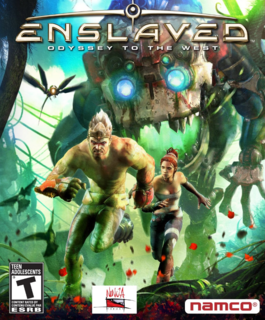great game
Of course, Enslaved has influences. Just about everything that exists (especially in 2010) has influences. What you do with them is where the new comes in. And, whether their presence is direct or coincidental, Enslaved synthesizes the familiar in a strong, fresh experience.
People are going to compare the opening of Enslaved to the opening of Uncharted 2, and, yes, there's some similarity. The hero in each is escaping a massive, crashing conveyance by means of utterly impressive platforming. But, Enslaved leaves the recognizable reality of Uncharted far behind and even as Monkey's leaping and grabbing and fighting, you're getting told about a world, about a history.
I talked about the story a bit in my preview but the short version if you're in the dark: in a future where giant airborne slave ships abduct people, one such captive named Trip escapes and compels Monkey–a super-strong, super-agile loner–to help her make it home safely. Monkey's obedience is secured by way of a pain-inducing tech headband she's attached to him. If he wanders to far from Trip, he'll throb with pain. And–because the headband ties their two life signs together–if she dies, he dies. The slavery subtext of Odyssey to the West is grim, and the game doesn't make light of what it's done to the world.
The milieu of Enslaved feels more than lived-in. The texture of it feels sand-blasted, painted over, then baked in desert heat and then sand-papered. The visual design–which looks amazing throughout–holds a history of breaking down and starting over in its pixels. You don't need to be told about the multiple world wars that must've happened as all the debris tells that story. With the weight of all that, it almost explains Trip's indenturing of Monkey. In a world this scarred and paranoid, a slip of woman enslaving a gruff bruiser to help her make it home almost makes sense. Almost.
The key themes of Enslaved are freedom, limitation and the symbiosis between the two. And that sensibility comes out in the design, too. Even though she's trapped him, Trip can heal Monkey and upgrade his abilities. He, in turn, can command her to project a decoy to draw enemy fire or tell her to run to cover while he draws the bad guys' attention. The AI co-op mechanic sets up a nice rhythm that bounces back between Trip and Monkey. Thankfully, Enslaved isn't too pedantic about giving out hints, so you'll actually need to figure out if it "distract then move" or "decoy, then distract, then fight" in certain instances.
Enslaved throws a lot of different gameplay flavors into the mix. The bulk of the combat is melee brawling with Monkey's staff, and it feels smooth, quick and brutal. Most refreshingly, all of the different types of mechs have unique attack patterns and weaknesses and they come at you in varied waves, so things stay challenging even deep into the game. Occasionally, there'll be stealth in certain sections, too. There's also turret shooting, vehicular combat and high-speed traversal on his Cloud hoverboard, both of which make for a nice change. Ninja Theory executes all of these pretty well, which shows real growth for a studio whose first game–the PS3 launch game Heavenly Sword–was almost exclusively combat.
You'll occasionally come across a few signs that the game could've used a touch more polish: infrequent slowdown, twitchy camera, occasional collision hiccups and mysterious save points. Of these, the camera's the most annoying. It's a bit twitchy and it sucks that you can't automatically re-center. Sometimes, it suddenly locks to a new perspective when you enter a new area and the switch will throw you off. Slightly less annoying is the fact that there's no transparency to the save structure. If you just want to turn off the game and do something else, you'll have no idea where you'll be when you start up again.
But, the things Enslaved does well, it does excellently and they more than offset the troubleseome parts of the game. Visually, it's one of the best-looking games of 2010. In addition to how the gameworld looks, characters' faces are incredibly expressive in Enslaved. There are times when you can tell what they're thikning before they even speak. Distinguished motion actor Andy Serkis–best know as Gollum from Peter Jackson's Lord of the Rings movies– plays Monkey and directed all the performance captures for the game, too. The story's been written by Alex Garland–author of The Beach and screenwriter on 28 Days Later– and gives a nice naturalistic feel to the evolving relationship between Monkey and Trip throughout the adventure. The facial expression technology actually makes the occasionally flat dialogue comes across more meaningfully. Make no mistake, though, the voice acting is top-notch. When the moment calls for it, Serkis can sound by turns cranky, bemused, enraged or concerned. The other actors who do the main characters–Lindsey Shaw for Trip and Richard Ridings for Pigsy–hold their own, too, with Riding's Pigsy stealing the show at times. Video game plots always expect you to believe that characters grow to care about each other but, in Enslaved, you can see it on their faces.
To wrap up, Ninja Theory's title feels epic, but never like it's trying too hard. Enslaved presents the prettiest post-apocalypse you ever did see with a strong underlying design and great world-building. The gameplay isn't ever super-difficult but provides nice challenges and variation throughout. The performances and the art direction earn high marks for their impressive execution and conception. Every so often, I indulge in the thinking that video games are the best modern medium when it comes world-building. Games like Enslaved: Odyssey to the West make that thought easy to believe.

